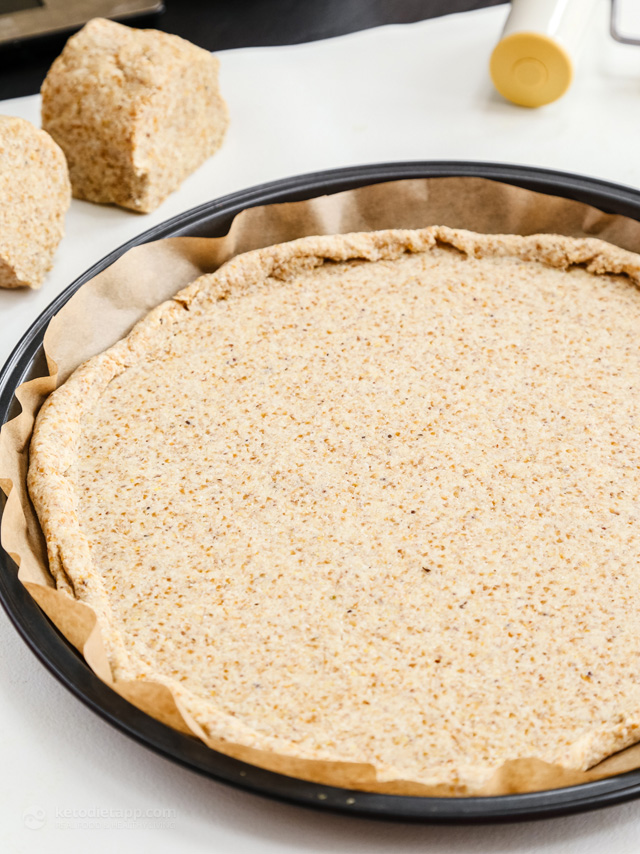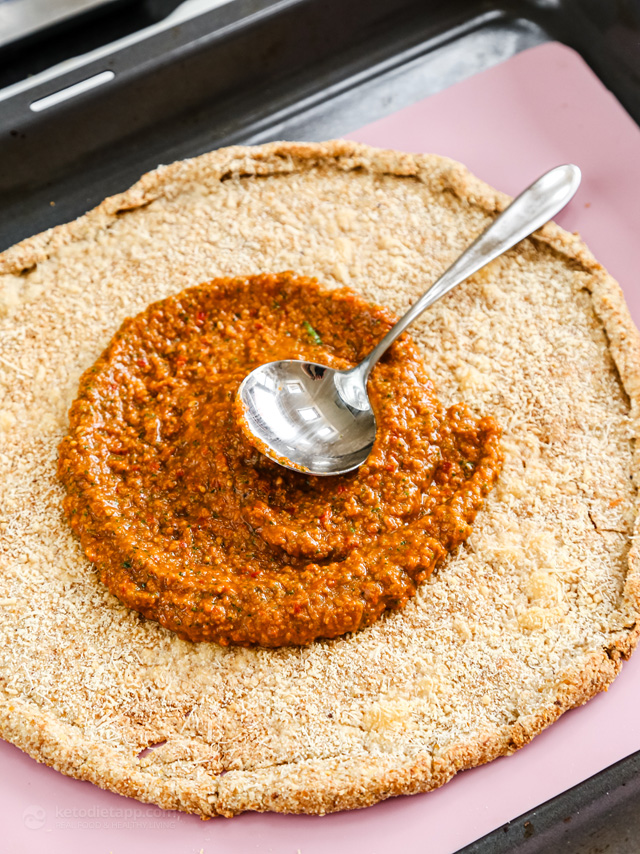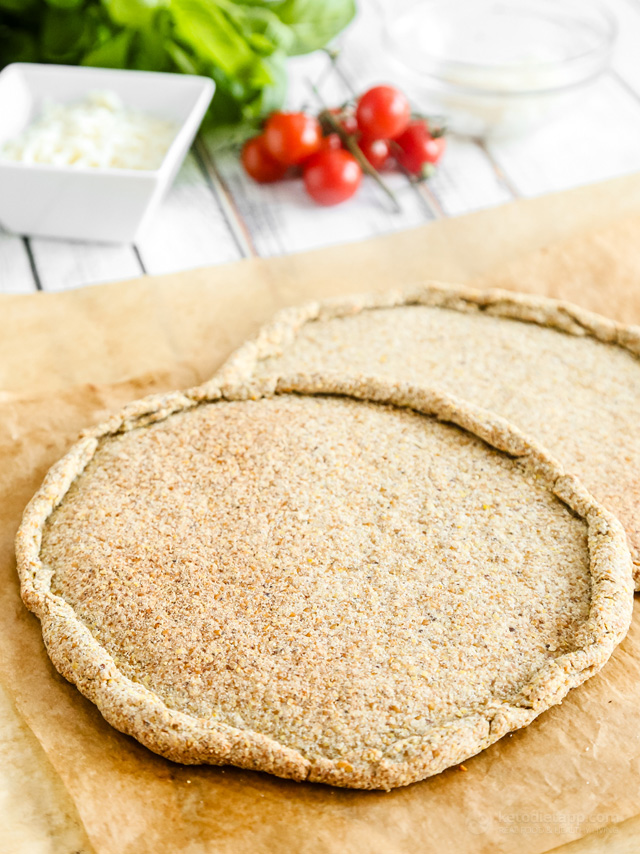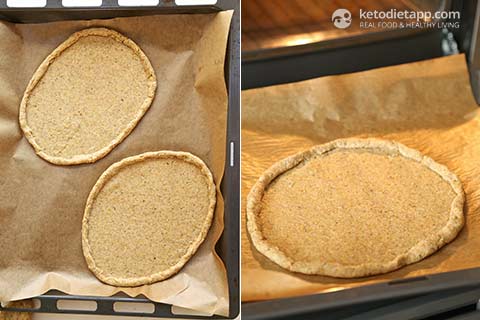Follow us 148.4k
If you’ve been missing a thin and crispy pizza crust on a keto or low-carb diet, this recipe is about to change that. It’s light, flexible, and sturdy enough to hold all your favorite toppings — no soggy base here!
What makes this keto pizza crust extra special is its simplicity. Made with a blend of almond flour, flax meal, coconut flour, and psyllium husks, it’s naturally grain-free, gluten-free, egg-free, and dairy-free, making it suitable for almost any dietary need, including vegan.
I first created this crust as a spin-off of my popular keto tortilla dough, and it quickly became one of my go-to recipes. It’s the perfect blank canvas for classics like pepperoni, veggie-loaded pies, or even creative twists like cheeseburger or breakfast pizzas.
Why You’ll Love This Keto Pizza Crust
- Thin & crispy – Bakes up with the crunch of traditional thin crust pizza.
- Sturdy base – Holds toppings without falling apart or going soggy.
- Diet-friendly – Grain-free, gluten-free, egg-free, dairy-free, and vegan.
- Versatile – The same dough works for pizza, flatbreads, or even breadsticks.
- Simple ingredients – Pantry staples, no gums or weird binders needed.
- Make ahead – Store crusts for quick weeknight pizzas or meal prep.
Ingredients & Swaps
- Almond flour – Creates structure and a mild, nutty flavor. For a nut-free version, use the same amount of ground sunflower seeds. You can even use more flax meal (you’ll need extra water to compensate).
- Flax meal – Adds bulk, fiber, and binding. Golden flax meal gives a lighter color, brown flax makes it darker.
- Coconut flour – Helps absorb moisture and balance the texture. If avoiding coconut, use more flax meal.
- Whole psyllium husks – Keep the dough flexible and easy to roll. Psyllium powder can be used, but the texture will be denser.
- Ground chia seeds – Add binding power, similar to flax. If you want to swap it, use flax meal (you might need to tweak the amount of water as chia seeds are more absorbent).
- Sea salt – Balances flavor and can be used to taste.
- Water – Use lukewarm for best absorption; add a little more if the dough feels too dry.
- Optional Parmesan – Sprinkled on the crust before baking to “seal” it and prevent sogginess once toppings are added.
 Follow us 148.4k
Follow us 148.4k
Can I make flavored pizza crusts?
Yes! In my very first published cookbook (The KetoDiet Cookbook, 2015), I included variations to add extra flavor and color to this crust. You can mix in herbs and spices like garlic powder, onion powder, paprika or dried herbs. You can use turmeric for a golden crust, paprika for a red crust with a mild smoky kick, or cooked spinach (well squeezed) for a beautifully green crust that’s nutrient-packed. These add-ons make the crust fun, vibrant, and even more delicious.
What’s the difference between whole psyllium husks and psyllium powder?
Whole husks make the dough more pliable and easier to roll thin without tearing. Powdered psyllium absorbs more liquid and creates a denser texture, which is better for bread recipes. Stick with whole husks here if you want flexibility.
Can I make this crust without flax meal?
Yes, but you’ll need a binder to replace it. Ground chia seeds can work, though they’ll make the crust a bit chewier. If you swap all of the flax for chia, add extra water as chia is more absorbent.
How do I prevent the crust from getting soggy once I add toppings?
Bake the crust until firm before adding any sauce or cheese. For extra insurance, sprinkle Parmesan (or even mozzarella) on the base after the first bake — this “seals” the crust so moisture doesn’t soak through.
 Follow us 148.4k
Follow us 148.4k
Tips for Best Results
- Weigh your ingredients – A kitchen scale gives more accurate results than cups, especially for flours like almond, coconut, or flax meal.
- Rest the dough – Letting it sit in the fridge allows the psyllium and chia to fully hydrate, making it easier to roll out thin.
- Roll thin, but not paper-thin – Aim for 2–3 mm (about 1/8 inch). Too thick and it won’t crisp; too thin and it may crack.
- Seal with cheese – A light sprinkle of Parmesan before baking creates a barrier, keeping sauces and toppings from soaking in.
- Bake until firm before topping – Don’t rush this step. A sturdy base is the key to a crispy, holdable slice.
- Cool slightly before slicing – Just like regular pizza, letting it rest for a couple of minutes helps the crust firm up and prevents crumbling.
Storage Tips
This keto pizza crust keeps really well, making it a great prep-ahead option. Store cooled crusts in an airtight container or wrap tightly and refrigerate for up to 1 week. For longer storage, freeze between sheets of parchment and place in a freezer-safe bag for up to 3 months.
When ready to use, thaw at room temperature (if frozen), then crisp the crust briefly in a hot oven before adding your toppings. This will refresh the texture and keep it sturdy for baking.
 Follow us 148.4k
Follow us 148.4k
Keto Pizza and Other Recipes You’ll Love
This versatile thin crust is the perfect base for all your favorite low-carb pizzas. Here are some of our reader-favorite recipes made with this dough.
Hands-on Overall
Serving size 1 small pizza crust
Nutritional values (per 1 small pizza crust)
Net carbs2.5 grams
Protein8.4 grams
Fat18.3 grams
Calories231 kcal
Calories from carbs 5%, protein 16%, fat 79%
Total carbs12.1 gramsFiber9.6 gramsSugars1.4 gramsSaturated fat2.1 gramsSodium395 mg(17% RDA)Magnesium123 mg(31% RDA)Potassium323 mg(16% EMR)
Ingredients (makes 6 small, or 3 large pizza crusts)
Instructions
- In a large bowl, mix together all of the dry ingredients. Add the lukewarm water and stir until combined. Let the dough rest in the fridge for 15–20 minutes. (This is the same dough I use in my tortilla recipe.)
- Meanwhile, preheat the oven to 200 °C/ 400 °F (fan assisted), or 220 °C/ 425 °F (conventional). Divide the dough into 6 pieces for small crusts (or 3 for large).
- Place one piece of dough between two sheets of baking paper and roll it out until very thin. Use your fingers to shape the edges into a rim that will hold the toppings.

- Alternatively, you can roll the dough using a silicone mat and a non-stick silicone roller for easier handling.

- Place the rolled-out crusts on a baking sheet lined with parchment paper. Optionally, sprinkle each crust with 2–4 tablespoons of grated Parmesan. This helps seal the dough and prevents it from getting soggy once toppings are added. Bake for 10–12 minutes, or until the crust is golden and crisp.

- Remove from the oven, add your favorite toppings (pepperoni, mushrooms, spinach, cheese, ground beef, eggs, etc.), and bake again until the toppings are cooked to your liking.
- If you don’t plan to use the crust immediately, let it cool completely and store in an airtight container or wrap for up to 2 weeks. This crust also works great in recipes like Florentine Pizza, Bolognese Pizza or Cheeseburger Pizza.

Ingredients
Instructions
- In a large bowl, mix together all of the dry ingredients. Add the lukewarm water and stir until combined. Let the dough rest in the fridge for 15–20 minutes. (This is the same dough I use in my tortilla recipe.)
- Meanwhile, preheat the oven to 200 °C/ 400 °F (fan assisted), or 220 °C/ 425 °F (conventional). Divide the dough into 6 pieces for small crusts (or 3 for large).
- Place one piece of dough between two sheets of baking paper and roll it out until very thin. Use your fingers to shape the edges into a rim that will hold the toppings.
- Alternatively, you can roll the dough using a silicone mat and a non-stick silicone roller for easier handling.
- Place the rolled-out crusts on a baking sheet lined with parchment paper. Optionally, sprinkle each crust with 2–4 tablespoons of grated Parmesan. This helps seal the dough and prevents it from getting soggy once toppings are added. Bake for 10–12 minutes, or until the crust is golden and crisp.
- Remove from the oven, add your favorite toppings (pepperoni, mushrooms, spinach, cheese, ground beef, eggs, etc.), and bake again until the toppings are cooked to your liking.
- If you don’t plan to use the crust immediately, let it cool completely and store in an airtight container or wrap for up to 2 weeks. This crust also works great in recipes like Florentine Pizza, Bolognese Pizza or Cheeseburger Pizza.
Nutrition (per serving, 1 small pizza crust)
Calories231kcal
Net Carbs2.5g
Carbohydrates12.1g
Protein8.4g
Fat18.3g
Saturated Fat2.1g
Fiber9.6g
Sugar1.4g
Sodium395mg
Magnesium123mg
Potassium323mg
Detailed nutritional breakdown (per 1 small pizza crust)
Do you like this recipe? Share it with your friends!